June 2015
Conferences
SAN FERMÍN CYCLE
ROUNDTABLE
The Royal Congregation of San Fermín de los Navarros on its CCCXXXth anniversary: history, heritage and current affairs
After the lecture given by Dr. Alberto Cañada on the Sanfermines as the setting for the first cinematograph sessions between 1896 and 1902, there was a roundtable moderated by Professor Fernández Gracia, director of the Chair of Navarrese Heritage and Art. Amalio de Marichalar y Sáenz de Tejada, vice-prefect of the Royal Congregation, and Professor Andueza Unanua, a member of the aforementioned Chair took part.
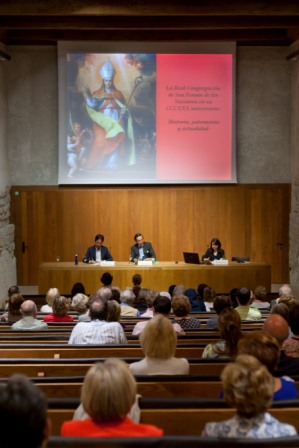
INTERVENTIONS
-
D. Amalio de Marichalar. Vice-prefect of the Royal Congregation of San Fermín de los Navarros.
24 June 2015
CONFERENCE
The Royal Congregation of San Fermín de los Navarros on its CCCXXXth Anniversary
D. Amalio de Marichalar y Sáenz de Tejada
Vice-prefect of the Royal Congregation of San Fermín de los NavarrosThe Royal Congregation of San Fermín de los Navarros celebrates 330 years since its foundation, its first Prefect being H.M. King Charles II. King Charles II, with the special task of worshipping the patron saint of Navarre, Saint Fermín, the first Spanish martyr and bishop, as well as invoking the help of God Our Lord and the Immaculate Virgin Mary in compliance with its constitutions; and the ideals of its congregants can be summed up in the registration which appears on the occasion of the Building of the church of San Fermín de los Navarros: "The sons of Navarre, resident in Madrid, lovers of their religious traditions, formed in 1683 their Congregation under the protection of their King Charles II, to honour the report of their Patron Saint, the glorious San Fermín. In 1744, at their own expense, they erected a church in the Prado ravine. Demolished in 1855, they returned in 1890 to build this one, conserving the same zeal as their ancestors, under the reign of Alfonso XIII".
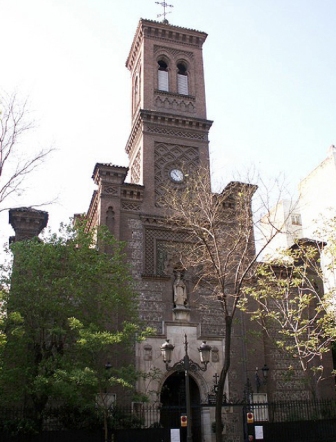
Façade of the church of San Fermín de los Navarros in Madrid
We are also celebrating the 125th anniversary of Building of the church and its dependencies, whose owner is the Royal Congregation, after being originally established in the convent of La Victoria, later moving to the Church of La Trinidad de Atocha, then to the Paseo del Prado, until its current location in Eduardo Dato.
The solemn blessing on 6 July 1890 was attended by H.R.H. the Infanta Isabel de Borbón, as well as the Vice-Prefect, the Count of Heredia Spinola and the board board of directors.
On 7 July, the Bishop of Pamplona, Don Antonio Ruiz Cabal, officiated at Holy Mass.
The Franciscan Fathers have also been governing the spiritual destiny of the Church of San Fermín de los Navarros for 125 years. Since 1885, the Franciscan Order had not had a residency program in the capital of Spain and this was achieved by establishing the headquarters of the General Apostolic Commissariat of the Franciscan Order for Spain in Madrid, in San Fermín, after all the steps taken between 1890 and 1891, signing the agreement between the General Commissary, Friar Serafín Linares, and the Vice-Prefect, Count of Heredia Spinola.
On 7 July 1891 there was a mass officiated by the bishop of Madrid, with a sermon by the Navarrese Jesuit, Fr. Astráin, which was attended by Their Majesties the Queen Regent and King Don Francisco de Asís, as well as H.R.H. the Infanta Isabel de Borbón.
approach At present, the Royal Congregation of San Fermín de los Navarros continues the spirit and work that saw its birth 330 years ago, with very specific lines of action on the spiritual level to increase its Christian commitment and collaborate with the parish and its many demands; on the cultural level, with the organisation of conferences and concerts, and traditional celebrations; and on the level of maintenance and works on its premises, with special emphasis on the comprehensive rehabilitation of all the buildings it owns and especially its church, which is now 125 years old.
The Royal Congregation, in this new stage, is also studying new projects for partnership with other institutions, including some with which it has already been collaborating, to make its proposals more dynamic and also to publicise the activities that have been consolidated for a long time now, for a better presence, knowledge and dissemination of what the spirit of Navarre and commitment to St. Fermin and St. Francis Xavier has always been.
At the beginning of this 21st century, Europe, more than ever, has been built on its deep Christian roots. Spain, as could not be otherwise, and the ancient Kingdom of Navarre, which contributed so much to the training of Spain, are an essential part of our common Christian culture, forged from the values and principles that we inherited from our elders and which we must pass on to the following generations.
The Royal Congregation wants to follow this path to honour the history that saw its birth, after more than three centuries and as the best proposal to win the future for the good of all.
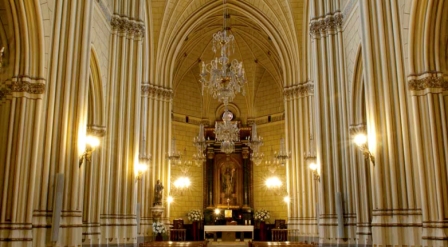
Interior of the church of San Fermín de los Navarros
-
Ms. Pilar Andueza Unanua. Chair of Navarrese Heritage and Art
24 June 2015
CONFERENCE
The Royal Congregation of San Fermín de los Navarros on its CCCXXXth Anniversary
Ms. Pilar Andueza Unanua
Chair of Navarrese Heritage and ArtIn the Villa y Corte of Madrid, transformed into the prototype of the Baroque convent city, the Royal Congregation of San Fermín de los Navarros was born on 7 July 1683, during the reign of Charles II, who became its perpetual prefect. In addition to parishes and numerous male and female monasteries, there were many hospitals, confraternities and congregations that proliferated at that time, either of general subject or guilds, as well as those from other countries or from other areas of the Iberian Peninsula. It was an institution of a religious, charitable and welfare nature that brought together Navarrese people who lived mainly in the Villa y Corte, but also in the Indies. They would be united under a common element, devotion to Saint Fermín, love for their land of origin, the kingdom of Navarre, as well as the desire to make a charitable contribution to Navarrese people in need.
One year later, its constitutions were approved, which would be reissued in the 18th century. The institution, headed by a prefect, was governed by a private board .
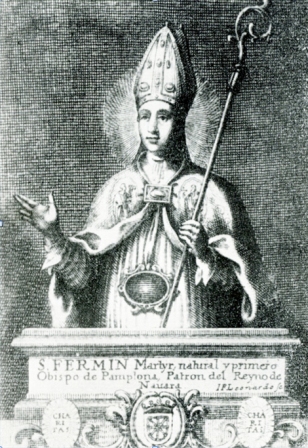
Engraving of San Fermín, by Juan F. Leonardo, published in the Constitutions of 1684.
The period of greatest splendour was reached by the institution during the Age of Enlightenment, coinciding with what Julio Caro Baroja called the "18th century Navarrese hour", a time when many of the congregants achieved a magnificent economic and social position by becoming important businessmen and gaining access to high positions in the government and the army, under the new Bourbon dynasty, as payment for their unconditional support in the War of the Spanish Succession. Among the most prominent men were Juan de Goyeneche, his sons and nephews, Juan Bautista Iturralde, Miguel Gastón de Iriarte, Jerónimo de Uztáriz and many other surnames such as the Lavaqui, Aldecoa, Jáuregui, Arizcun, Iturbierta, Mendinueta, etc., many of them from the Baztan valley. In fact, the Marquis of Saltillo would state in relation to this phenomenon: "at the beginning of the 18th century, Madrid was dominated by Navarrese, and more specifically, natives of Baztan".
The first headquarters of the congregation was in the chapel of La Soledad in the convent of La Victoria de los Padres Minimas de San Francisco de Paula, located at degree program de San Jerónimo, near the Puerta del Sol. The relic of the head of Saint Fermín was venerated there, and it was customary for Navarrese residents in Madrid to go there on the festivities of 7 July and 25 September to honour their patron saint. The congregation's presence there was short-lived, and in 1685 it looked for another site, which was found in the convent of the Trinitarians in Calle Atocha. In their new altar the Navarrese placed a carving of the saint made in 1686 by the Navarrese sculptor Roque Solano, also a member of the congregation, who some time later was also commissioned to make an image of Saint Francis Xavier.
They remained there until 1744, when its members, wishing to have their own headquarters, acquired the house and gardens that the heirs of the Count of Monterrey had between the Prado de San Jerónimo and Calle del Turco. There they adapted a gallery designed by José de Almelda as a chapel, becoming one of the most sumptuous ensembles of the Madrid Baroque, as it was endowed with an extraordinary set of altarpieces made by the mazonero Domingo Martínez de Arribas, which housed numerous altarpieces from the gouges of Luis Salvador Carmona and sponsored by various devout congregants. The congregation was also nourished by other works such as the Niño del Dolor, attributed to Alonso Cano, a canvas of San Fermín by Jiménez Donoso or the two patron saints of Navarre by the New Spain painter Juan Correa.
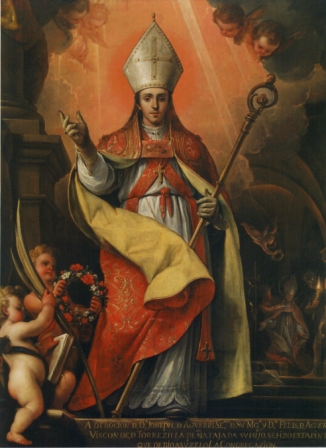
San Fermín, a work by Ximénez Donoso, preserved in the Royal Congregation of San Fermín de los Navarros.
The eventful 19th century was a time of decline for the congregation, which saw its activity decline and its facilities age. The construction of the Bank of Spain on the adjoining site and a magnificent economic offer from that banking institution was taken advantage of by its board president to sell the facilities in 1885 while searching for a suitable site on which to build the new headquarters of the congregation. The site was found in the Chamberí neighborhood, specifically on Paseo del Cisne, today Paseo de Eduardo Dato. A church was built there following the design project of Carlos Velasco and Eugenio Jiménez Corera, who opted for a historicist language of neo-medievalist style, where they fused neo-Mudejar and neo-Gothic elements, closely associated with the Alfonso restoration. Solemnly consecrated on July 6, 1890, the church received all the altarpieces and sculptures from its previous site, along with the liturgical furnishings. In 1936, at the outbreak of the civil war, the church was transformed into barracks by the militiamen and all its artistic patrimony was annihilated. Once the war was over, the congregation made an effort to restore the church's dignity refund . The Franciscans returned and little by little the decoration was restored, presided by an altarpiece installed in 1961 with a sculpture of Saint Fermin by Fructuoso Orduna.
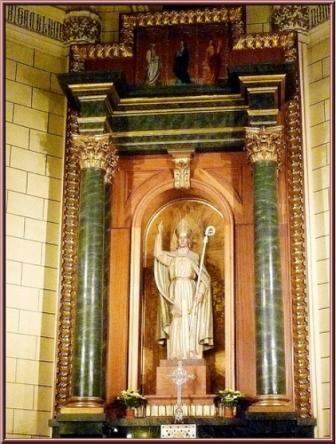
Main altarpiece, designed by José Yárnoz Larrosa,
presided over by a sculpture of San Fermín, the work of Fructuoso Orduna.
In 1995 the San Fermín de los Navarros complex was declared an Asset of Cultural Interest of Spanish Historical Heritage.
Today, 330 years after its foundation, the congregation is still alive and faithful to its founding principles as a Christian, charitable and welfare institution.
